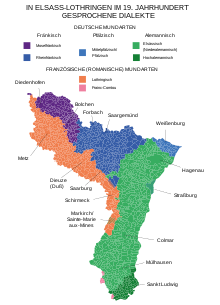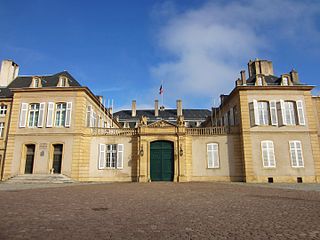
Moselle is the most populous department in Lorraine, in the northeast of France, and is named after the river Moselle, a tributary of the Rhine, which flows through the western part of the department. It had a population of 1,046,543 in 2019. Inhabitants of the department are known as Mosellans.
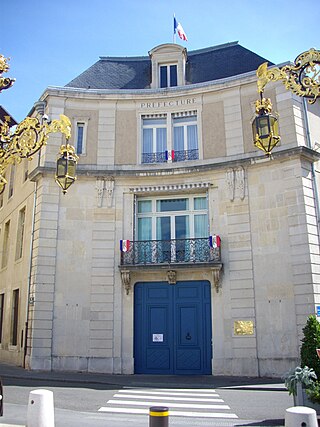
Meurthe-et-Moselle is a département in the Grand Est region of France, named after the rivers Meurthe and Moselle. Its prefecture and largest city is Nancy and it borders the departments of Meuse to the west, Vosges to the south, Moselle and Bas-Rhin and it borders the Belgian province of Luxembourg and the country of Luxembourg by the canton of Esch-sur-Alzette to the north. It had a population of 733,760 in 2019.

Bas-Rhin is a département in Alsace which is a part of the Grand Est super-region of France. The name means 'Lower Rhine', referring to its lower altitude among the two French Rhine departments: it is downstream of the Haut-Rhin department. Both belong to the European Upper Rhine region. It is, with the Haut-Rhin, one of the two departments of the traditional Alsace region which until 1871, also included the area now known as the Territoire de Belfort. The more populous and densely populated of the pair, it had 1,152,662 inhabitants in 2021. The prefecture is based in Strasbourg. The INSEE and Post Code is 67.

The Treaty of Frankfurt was a peace treaty signed in Frankfurt on 10 May 1871, at the end of the Franco-Prussian War.

Alsace–Lorraine, officially the Imperial Territory of Alsace–Lorraine, was a territory of the German Empire, located in modern-day France. It was established in 1871 by the German Empire after it had occupied the region during the Franco-Prussian War. The region was officially ceded to the German Empire in the Treaty of Frankfurt. French resentment about the loss of the territory was one of the contributing factors to World War I. Alsace–Lorraine was formally ceded back to France in 1920 as part of the Treaty of Versailles following Germany's defeat in the war, but already annexed in practice at the war's end in 1918.
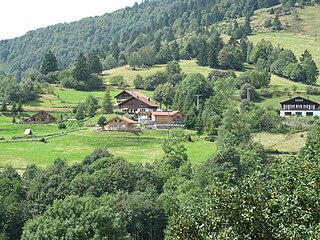
The Vosges are a range of medium mountains in Eastern France, near its border with Germany. Together with the Palatine Forest to the north on the German side of the border, they form a single geomorphological unit and low mountain range of around 8,000 km2 (3,100 sq mi) in area. It runs in a north-northeast direction from the Burgundian Gate to the Börrstadt Basin, and forms the western boundary of the Upper Rhine Plain.

Lorrain is a language spoken by now a minority of people in Lorraine in France, small parts of Alsace and in Gaume in Belgium. It is a langue d'oïl.

Meurthe is a former department of France created in 1790. Its prefecture (capital) was Nancy. It ceased to exist following the annexation of Alsace-Lorraine by Germany in 1871.

The Meurthe is a river in north-eastern France, right tributary to the river Moselle. It is 161 km (100 mi) long. Its source is in the Vosges mountains, near the Col de la Schlucht in the Vosges département, from where it flows in an overall north-westerly direction. Its name gave rise to the naming of the present French département Meurthe-et-Moselle and the former département Meurthe.

Lorraine is a cultural and historical region in Northeastern France, now located in the administrative region of Grand Est. Its name stems from the medieval kingdom of Lotharingia, which in turn was named after either Emperor Lothair I or King Lothair II. Lorraine, originally the southern or "upper" part of this kingdom, came to be ruled by the Holy Roman Empire as the Duchy of Lorraine before the Kingdom of France annexed it in 1766.

Sarrebourg is a commune of northeastern France.

Unterelsaß was the northern part of the historical region Alsace or Elsass. From 1871 to 1918, Bezirk Unterelsaß was the name for the central district (Bezirk) of the imperial territory of Elsaß-Lothringen (Alsace-Lorraine) in the German Empire.
The various toponyms in the historical region of Lorraine are often known by very different names depending on the language in which they are expressed. This article provides an understanding of the linguistic and historical origin of this diversity and lists a number of correspondences for communes and lesser localities in the four departments of the former region: Meuse, Meurthe-et-Moselle, Moselle, and Vosges.

The Greater Region, formerly also known as SaarLorLux, is a euroregion of eleven regional authorities located in four European states. The term has also been applied to cooperations of several of these authorities or of their subdivisions, administrations, organisations, clubs and people. Member regions represent different political structures: the Walloon region, comprising the French and German-speaking Communities of Belgium; the former Lorraine part of Grand Est, a region of France, including the French departments Meurthe-et-Moselle, Meuse, Moselle and Vosges; the German federated states of Rhineland-Palatinate and Saarland; and the sovereign state of Luxembourg.

Chicourt is a commune in the Moselle department in Grand Est in north-eastern France.

Bezirk Lothringen, also called German Lorraine, was a government region ("Bezirk") in the western part of Alsace-Lorraine when it was part of the German Empire from 1871 to 1918.
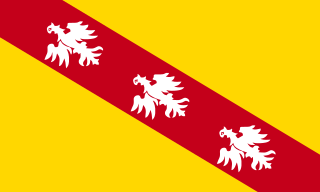
The Civil Administration Area of Lorraine was an administrative division of the Gau Westmark from 1940 to 1945.

Grand Est is an administrative region in northeastern France. It superseded three former administrative regions, Alsace, Champagne-Ardenne and Lorraine, on 1 January 2016 under the provisional name of Alsace-Champagne-Ardenne-Lorraine, as a result of territorial reform which had been passed by the French Parliament in 2014.
Between the 16th and 18th centuries, Alsace and Lorraine, territories of the Holy Roman Empire located between the Meuse and Rhine rivers, were annexed by the Kingdom of France. Part of these same territories were annexed by the German Empire in the 19th century, then by the Third Reich in the 20th century, before returning to French rule at the end of World War II.

